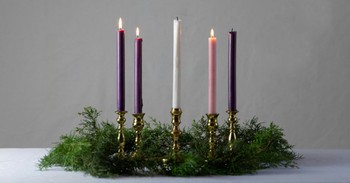During national Pride Month, people can spot the rainbow flag in the windows of businesses, in front of people’s homes, and incorporated into shirts and accessories. The colorful flag has become synonymous with the LGBTQIA+ movement. So, whenever we see someone wave a rainbow flag, we understand the message – that person is either a member of the LGBTQIA+ community or a supporter of it.
However, we may wonder how a naturally occurring phenomenon – a rainbow – came to be identified with a movement advocating for inclusive views of sexuality and gender. Why choose a rainbow to symbolize pride? And how does this relate to the rainbow’s origins according to the Bible?
To understand the rainbow flag and its enduring presence, we will have to consider its beginnings associated with the gay rights movement, though the rainbow symbol’s true meaning has ancient roots dating back to the time of Noah.
History of the Rainbow as an LGBTQIA+ Community Symbol
There was no single identifying symbol for the LGBTQIA+ community in the early days of the gay rights movement, which started gaining ground after the Stonewall Riots in 1969. Some had used the pink triangle despite its sinister past (though today it is a reclaimed symbol for the LGBTQIA+ community). Multiple years before, the Nazis had pinned pink triangles to those in prison camps who practiced homosexuality – individuals who were specifically targeted by the Nazi regime. Many of those who were forced to wear the pink triangles were killed in concentration camps.
So, when Harvey Milk encouraged Gilbert Baker to create a symbol for the gay community, Baker steered away from the pink triangle. Instead, he chose the rainbow to represent pride in the LGBTQIA+ community, and the first flags were flown in 1978. Because a rainbow has various colors that occur together, it could serve as a symbol of the diverse community and its unified mission. As noted in a Britannica article by Nora Gonzalez, each of the colors of the original flag had a special meaning: “hot pink for sex, red for life, orange for healing, yellow for sunlight, green for nature, turquoise for art, indigo for harmony, and violet for spirit.”
However, widespread production of the flag required some of the colors to be changed or removed. To help with these manufacturing issues, the flag’s design was modified into what it is today – a rainbow flag consisting of red, orange, yellow, green, blue, and violet. This pattern differs from the original design but corresponds generally with the naturally occurring rainbow.
Underpinning the use of the rainbow as a symbol of gay pride is the belief that sexuality and gender are fluid concepts and can be represented in many ways. This diversity is shown through the individual colors of the flag. Yet together, they portray the unified mission of pursuing freedom for those within the LGBTQIA+ movement.
The legacy of the rainbow flag continues today as people celebrate Pride month with parades and other events, specifically toward the end of June, to remember the impact of the Stonewall Riots. Rainbow flags, buntings, and banners adorn these festivals, and participants can be seen proudly waving flags. The rainbow is now a recognizable and universal symbol for LGBTQIA+ pride.
Biblical Origin of the Rainbow Symbol
Long before the rainbow was associated with Pride month, though, it was connected to a promise. God had sent a great flood to destroy the earth during the days of Noah. Wickedness had spread, and people had all turned away from the Lord to follow violence (Genesis 6:5-7, 11-12). One man, however, stood out as someone who continued to walk with God despite the evil surrounding him: Noah (Genesis 6:8-9).
God wanted to save Noah and his family from the coming destruction and so instructed Noah to build an ark (Genesis 6:13-14). This large, sea-worthy vessel would preserve them and pairs of all the creatures of the earth (Genesis 6:19). In a major act, the Lord rescued Noah and brought him safely to restored land so that the world could again be filled with life – with beasts of the field, birds of the air, and with people (Genesis 8:15-17).
When He had done this, He made a covenant with Noah, his sons, and all the animals, promising never to flood the earth again. As detailed in the Genesis account, “I establish my covenant with you: Never again will all life be destroyed by the waters of a flood; never again will there be a flood to destroy the earth” (Genesis 9:11, NIV). The sign of this covenant was the rainbow in the sky. God promised that “Whenever the rainbow appears in the clouds, I will see it and remember the everlasting covenant between God and all living creatures of every kind on the earth” (Genesis 9:16). Although the rain had fallen continuously to make the waters rise and flood the earth, that would never happen again. The rain would come, but the clouds would eventually break, and the rainbow would appear – a visual reminder of God’s covenant with humankind and all the creatures of the earth. Never again would He flood the earth.
The account shows God’s love and mercy for all He created. He could have wiped every form of life from the earth because of His sorrow at seeing His previously good creation corrupted by the vile actions of humans. And He would have acted justly in doing so. Yet, He provided salvation for a family to continue the line of Adam and Eve, despite what humans had already done. The lives of the creatures of the earth would also continue, accomplishing God’s good plan to see the earth filled with life.
In the symbol of the rainbow, we find a beautiful reminder of God’s grace and provision. Ever since the time of Noah, it has served as a visible sign of the covenant between the Lord and all creation. When we see it, our thoughts should naturally turn to the events of the flood and the mighty act of salvation by our God.
Other Examples of the Rainbow in Scripture
Not only is the rainbow a sign of the covenant God made with all creation, but it is also associated with the glory of God. In Ezekiel’s vision of the Lord, he witnessed the awesome radiance of God. He compared the Lord’s throne with the beauty of precious stone, lapis lazuli (Ezekiel 1:26). And the One on the throne appeared in fiery glory (Ezekiel 1:27). As Ezekiel explained, “Like the appearance of a rainbow in the clouds on a rainy day, so was the radiance around him” (Ezekiel 1:28, NIV).
The Apostle John later recorded a similar vision to that of the prophet Ezekiel. In Revelation, though, the rainbow is specifically seen around the throne of God. John wrote about what he saw: “A rainbow that shone like an emerald encircled the throne” (Revelation 4:3, NIV). Whether the mention of the emerald indicated a certain color or merely acted as a prism is not clear or agreed upon by commentators. What we do know is that the Lord’s radiant presence was symbolized through the beauty of a rainbow.
Original readers of these descriptions would naturally think back to Genesis 9 and the promise of the Lord. He who made the promise of mercy and grace to Noah is the same Lord who sits enthroned in heaven and who will bring about His judgment on the earth in the future. In Revelation, we are presented with vivid imagery about God’s wrath poured out on sinful humankind. This time, the world will not be judged with water, but with fire (2 Peter 3:6-7). Yet, even with these righteous judgments, grace is present. Those who trust in the Lamb who had been slain will be saved and brought through the times of wrath safely – even if martyred – to the inheritance promised long ago (see Revelation 5:6-10). They will live forever with the Lord, all because of the love and grace that was shown to them (Revelation 21:1-4).
Within its ancient biblical meaning, the rainbow symbolizes the grace, faithfulness, and love of the living Lord.
Understanding the Pride Symbol in Light of the Biblical Rainbow
When we see the Pride flags flying in June, we can turn our thoughts to the rainbow as a symbol of God’s great mercy. He promised not to flood the earth again, and His kindness extended to humankind and the creatures of the earth. Today, His promise stands, and He continues to show mercy.
For like the ark that rescued Noah and his family, Christ saves those who trust in Him, since the ark prefigured the even greater work of our Savior. His salvation is not only offered to a few, but to all regardless of nationality, background, or gender, even though none of us are deserving of His mercy – that is why it is called grace (Ephesians 2:8-9; 1 Timothy 2:3-6).
The gospel is for all people, including those who identify as members of the LGBTQIA+ community. Jesus can meet them where they are and draw them into an everlasting fellowship with Himself. In Christ, all are brought into a loving family, washed and made new, and given the identity of sons and daughters, regardless of past sins (see 1 Corinthians 6:9-11).
Rainbows are symbols that remind us of how mercy triumphs over judgment (James 2:13). May we extend that same sense of grace to others, including those we do not agree with, and lovingly point them to our Savior.
Photo Credit: Photo Credit: ©iStock/Getty Images Plus/NATALIA DE LA RUBIA





